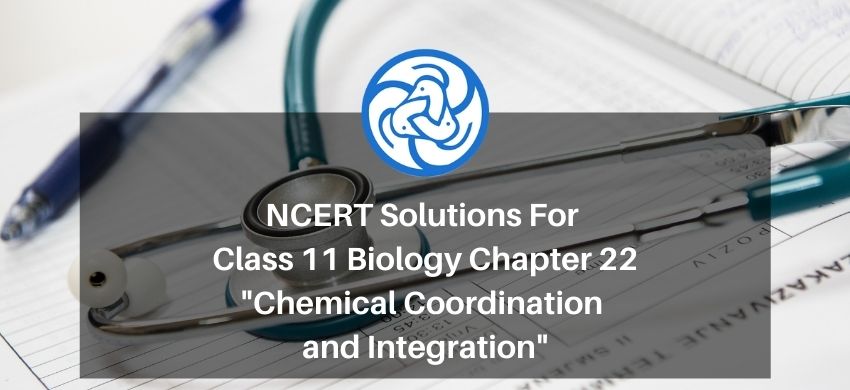
NCERT Solutions for Class 11 Biology chapter 22 Chemical Coordination and Integration PDF
Hey, are you a class 11 student and looking for ways to download NCERT Solutions for Class 11 Biology chapter 22 Chemical Coordination and Integration PDF? If yes. Then read this post till the end.In this article, we have listed NCERT Solutions for Class 11 Biology chapter 22 Chemical Coordination and Integration in PDF that are prepared by Kota’s top Doctor’s Faculties by keeping Simplicity in mind.
If you want to learn and understand class 11 Biology chapter 22 "Chemical Coordination and Integration" in an easy way then you can use these solutions PDF.
NCERT Solutions helps students to Practice important concepts of subjects easily. Class 11 Biology solutions provide detailed explanations of all the NCERT questions that students can use to clear their doubts instantly.
If you want to score high in your class 11 Biology Exam then it is very important for you to have a good knowledge of all the important topics, so to learn and practice those topics you can use eSaral NCERT Solutions.
In this article, we have listed NCERT Solutions for Class 11 Biology chapter 22 Chemical Coordination and Integration PDF that you can download to start your preparations anytime.
So, without wasting more time Let’s start.
Download NCERT Solutions for Class 11 Biology chapter 22 Chemical Coordination and Integration PDF
Question1. Define the following:
(a) Exocrine gland
(b) Endocrine gland
(c) Hormone
Solution. (a) Exocrine gland: Exocrine glands secrete their products into ducts that lead to the target tissue. For example, enzymes. The salivary gland secretes saliva into the collecting duct, which leads to the mouth.
(b) Endocrine gland: Endocrine glands secrete their products directly into the blood. For example, hormones. Insulin is a peptide hormone produced in beta cells of the pancreas that allows your body to use glucose from the food that you eat for energy or to store glucose for future use.
(c) Hormone: Hormones are chemical organic substances secreted in plants and animals that act like messenger molecules in the body. After being made in one part of the body, they travel to other parts of the body where they control how cells and organs do their work. For example, Insulin is a peptide hormone produced in beta cells of the pancreas that allows your body to use glucose from the food that you eat for energy or to store glucose for future use.
Question 2. Diagrammatically indicate the location of the various endocrine glands in our body.
Solution.
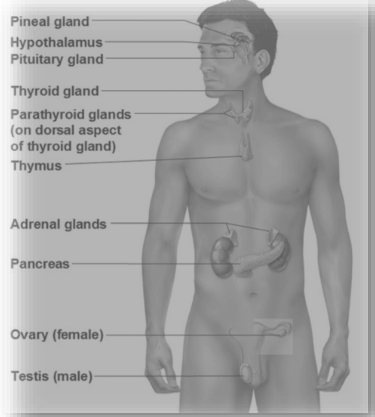
Figure: Location of the various endocrine glands in our body
Question 3. List the hormones secreted by the following: Solution. (a) Hypothalamus (b) Pituitary (c) Thyroid (d) Parathyroid (e) Adrenal (f) Pancreas
(g) Testis (h) Ovary (i) Thymus (j) Atrium (k) Kidney (I) G-I Tract
Solution.
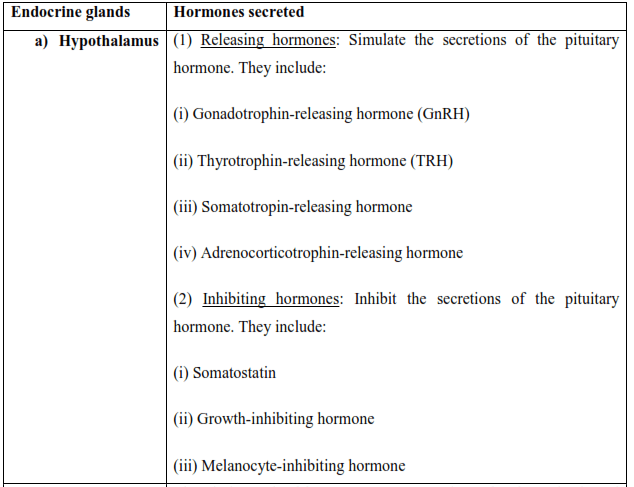
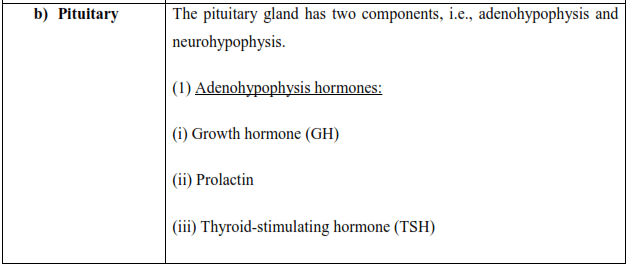
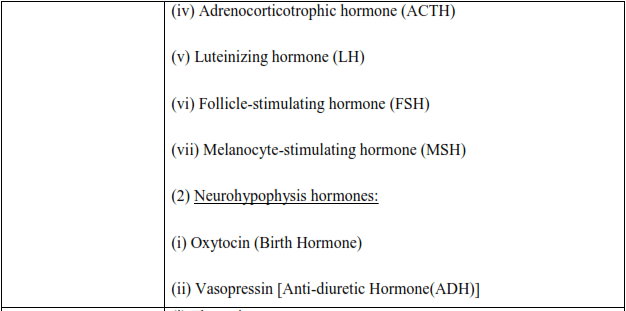


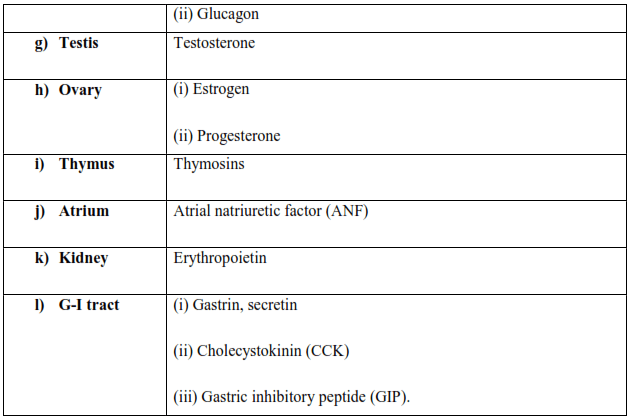
Question 4. Fill in the blanks:

Solution.

Question 5. Write short notes on the functions of the following hormones:
(a) Parathyroid hormone (PTH) (b) Thyroid hormones (c) Thymosins (d) Androgens (e) Estrogens
(f) Insulin and Glucagon
Solution. a. Parathyroid hormone (PTH): Parathyroid glands secrete a peptide hormone named parathyroid hormone (PTH). It increases the level of calcium in the blood. It also promotes the reabsorption of calcium from nephrons and promotes the absorption of calcium from digested food. Therefore, it plays an important role in maintaining a balance of calcium in the body.
b. Thyroid hormones: The thyroid gland secretes thyroxine, triiodothyronine, and thyrocalcitonin.
Thyroxine $\left(\mathrm{T}_{4}\right)$ maintains the basal metabolic rate of the body and regulates the metabolism of carbohydrate, fat, and protein. Thyroid hormones also support the process of red blood cell formation and to maintain water and electrolyte balance.
Thyrocalcitonin or calcitonin lowers calcium level in blood plasma. It plays a significant role in calcium levels along with the parathyroid hormone.
Triiodothyronine $\left(\mathrm{T}_{3}\right)$ plays a significant role in almost all the vital functions of the body like metabolic rate, heart and digestive functions, muscle control, brain development and its function, and the maintenance of bones.
c. Thymosins: The thymus gland secretes thymosin. It plays a significant role in protecting the body against infectious agents. It helps in the differentiation of T-lymphocytes and also promotes the production of antibodies. Hence, it offers both humoral and cell-mediated immunity. Thymosin also helps in the development of sex glands.
d. Androgens: Leydig celis of iestis produre anürogens such as testosierone. Tesiosierone is a male sex hormone that controls the development of secondary sex characters like the growth of the reproductive organs, facial hairs, hoarse voice, etc. Androgens also regulate the functions, development, and maturation of male accessory organs such as epididymis and prostate glands. It stimulates spermatogenesis for the formation of mature sperms and also influences male sexual behaviour.
e. Estrogens: Estrogen is synthesised and secreted by the growing ovarian follicles. It is the female sex hormone that controls the development of secondary sex characters like enlargement of mammary glands, high pitch voice, etc. It plays an essential role in the growth and development of female secondary sex organs. It also helps in the development of growing ovarian follicles. It influences female sexual behaviour.
f. Insulin and Glucagon: The pancreas secretes insulin and glucagon to maintain the homeostasis of glucose levels in the blood.
\alpha-cells of the pancreas secrete glucagon, which increases the blood glucose during the hypoglycemic condition in the body. Additionally, glucagon is responsible for the process of gluconeogenesis/glycogenolysis, which contributes to hyperglycemia. Glucagon reduces cellular uptake and utilisation of glucose.
$\beta$-cells secrete insulin that lowers blood glucose during the hyperglycemic state in the body. Additionally, insulin is responsible for the conversion of glucose to glycogen (glycogenesis) in the target cells, which contributes to hyperglycemia. Insulin increases cellular uptake and utilisation of glucose.
Question 6. Give example(s) of:
(a) Hyperglycemic hormone and hypoglycemic hormone
(b) Hypercalcemic hormone
(c) Gonadotrophic hormones
(d) Progestational hormone
(e) Blood pressure lowering hormone
(f) Androgens and estrogens
Solution. (a) Hyperglycemic hormone and hypoglycemic hormone: Hyperglycemic hormone is glucagon, and the hypoglycemic hormone is insulin.
(b) Hypercalcemic hormone: Parathyroid hormone (PTH)
(c) Gonadotrophic hormones: Luteinizing hormone (LH) and follicle-stimulating hormone (FSH)
(d) Progestational hormone: Progesterone
(e) Blood pressure-lowering hormone: Nor-adrenalin
(f) Androgens and estrogens: An example of androgen is testosterone, and an example of estrogen is estradiol.
Question 7. Which hormonal deficiency is responsible for the following:
(a) Diabetes mellitus
(b) Goitre
(c) Cretinism
Solution. (a) Diabetes mellitus: It is characterised by abnormally high glucose levels in the blood due to the deficiency of insulin hormone secreted by the pancreas.
(b) Goitre: It is characterised by an abnormal enlargement of the thyroid gland due to the iodine deficiency that causes hypothyroidism due to reduced levels of $\mathrm{T}_{3}$ and $\mathrm{T}_{4}$ hormones secreted by the thyroid gland.
(c) Cretinism: It is characterised by stunted growth in the baby due to the deficiency of $\mathbf{T}_{3}$ and $\mathrm{T}_{4}$ hormones secreted by the thyroid gland (hypothyroidism) in pregnant women.
Question 8. Briefly mention the mechanism of action of FSH.
Solution. - Follicle-stimulating hormone (FSH) is secreted by the pars distalis region of the anterior pituitary. FSH is essential for pubertal development and the function of women's ovaries and men's testes.
- In females, FSH stimulates the growth and maturation of ovarian follicle. As the follicle grows and matures, the granulosa cells of the ovarian follicles in the ovaries release an inhibitory hormone known as inhibin that suppresses the process of FSH production.
- In males, FSH is required for spermatogenesis within the specialised cells of testes called Sertoli cells. Once mature sperms are produced, Sertoli cells release an inhibitory hormone known as inhibin that suppresses the process of FSH production.

Figure: Mode of action of FSH in females

Figure: Mode action of FSH in males
Question 9. Match the following:

Solution.

Also Read,
Class 11 Chemistry Notes Download.
Class 11 Biology Book Chapterwise Download.
Class 11 Biology Exemplar Chapterwise Download.
If you have any Confusion related to NCERT Solutions for Class 11 Biology chapter 22 Chemical Coordination and Integration PDF then feel free to ask in the comments section down below.
To watch Free Learning Videos on Class 11 Biology by Kota’s top Doctor’s Faculties Install the eSaral App
